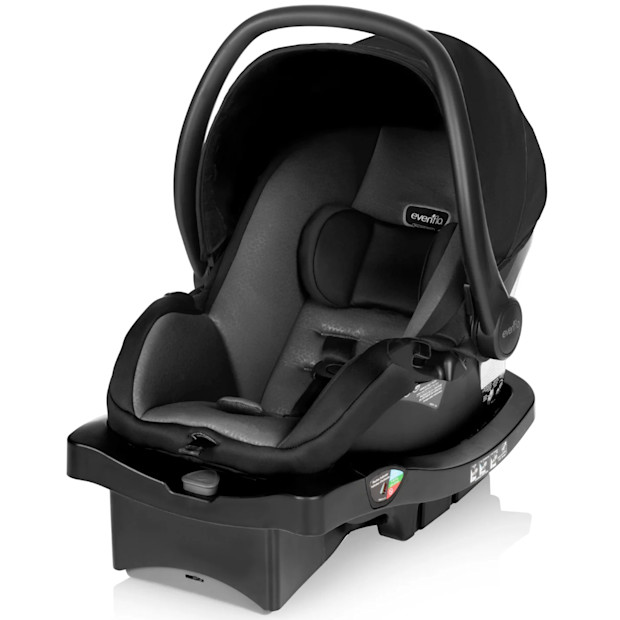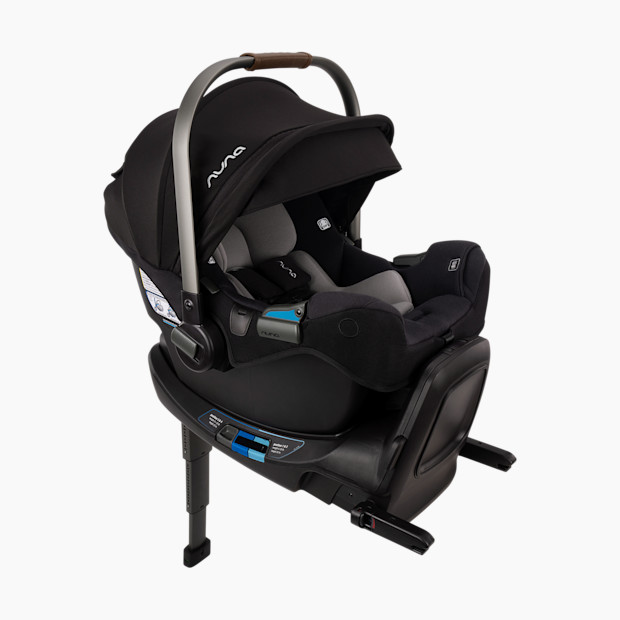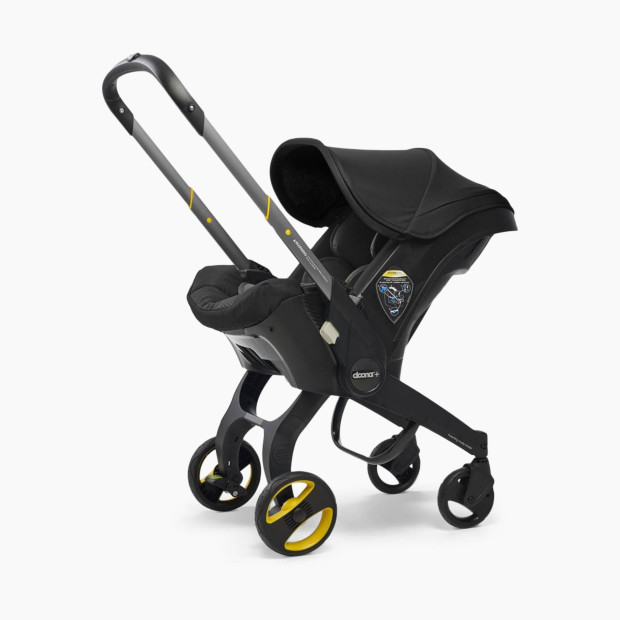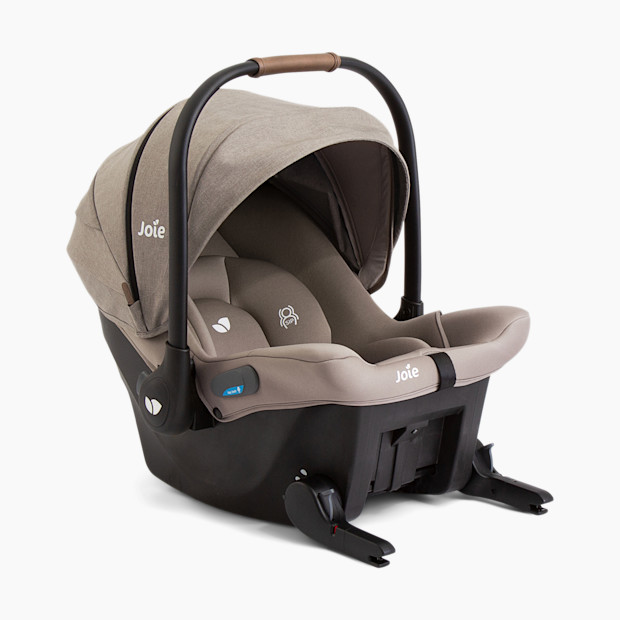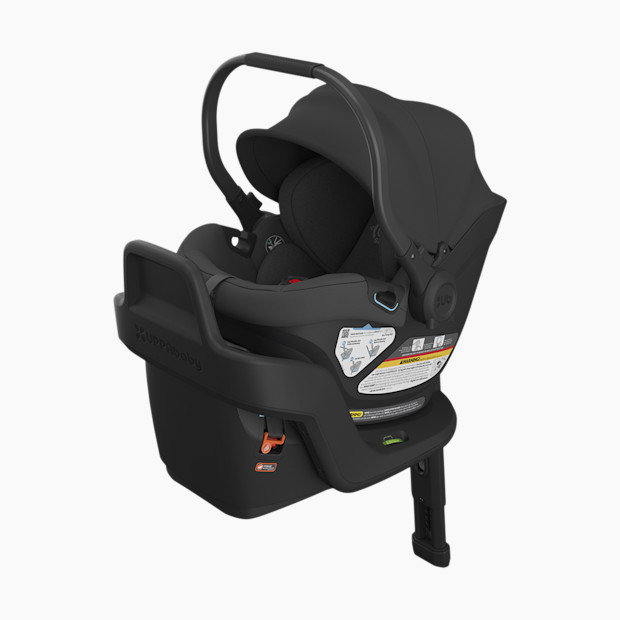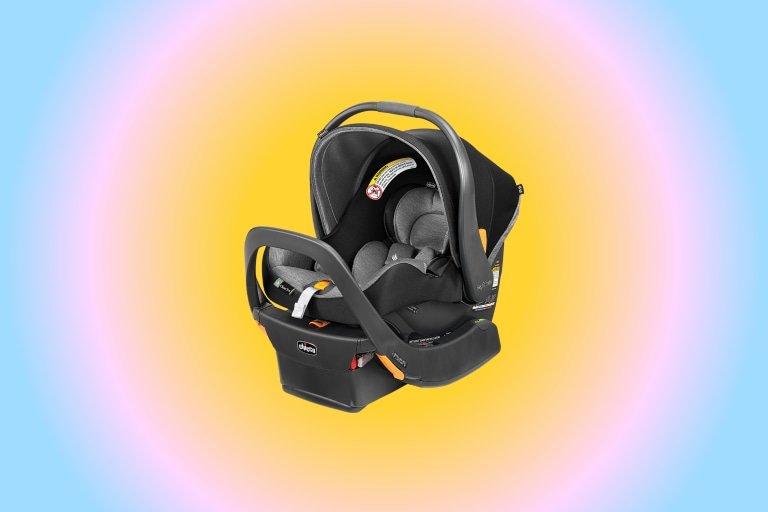
The Best Infant Car Seats of 2025
According to car seat experts and thousands of parents.

In This Article
An infant car seat is one of the most important items of baby gear you’re going to need as a new parent if you plan on driving with your baby—and one of the most confusing to research. If you’re looking for the best car seat for your family, we’re here to help.
As a Child Passenger Safety Technician (CPST, a specially trained car seat educator), I spent hours researching and real-world testing infant car seats, talking to other car seat safety experts and getting feedback from Babylist parents with years of experience. We think the Chicco KeyFit Max ClearTex Infant Car Seat stands out from the crowd as the best infant car seat overall.
It’s a safe, well-priced seat that’s easy to install, fits almost all newborns well and won’t take up too much space in your back seat. It’s also compatible with a wide variety of stroller brands to create a travel system, making getting out with your baby a little bit easier.
If you'd like to consider other options, there are many reliable infant seats across all different price points to fit your family’s needs. Evenflo's LiteMax 30 nabs our top spot for the best affordable seat, while the Nuna Pipa Rx with Relx Base is our favorite upgrade pick. We also included a roundup of the best seats to suit particular needs, such as if you want an ultra-lightweight seat or a seat that fits in a compact car.
- Best for Small Cars
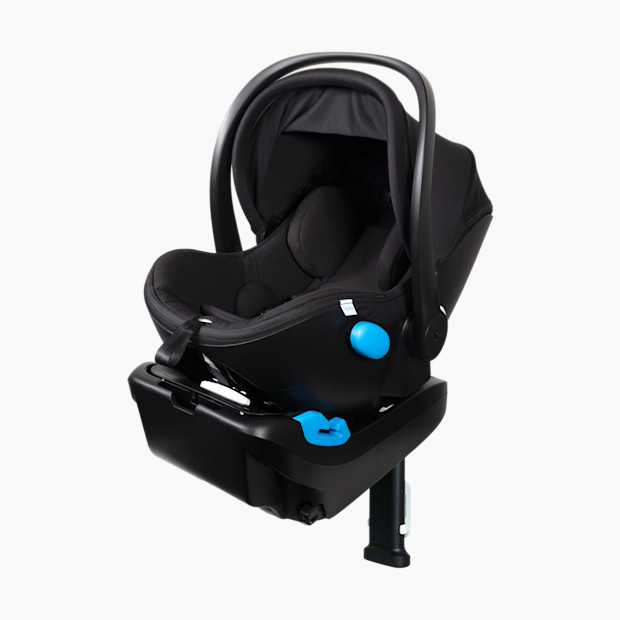 Clek Liing Infant Car Seat - Railroad Ziip (Flame Retardant Free)From $499.99
Clek Liing Infant Car Seat - Railroad Ziip (Flame Retardant Free)From $499.99
Why Trust Babylist?
Babylist is the expert in baby; we know baby gear inside and out. We talk with parents face-to-face in our showroom and on our user panels and hear from thousands annually via our Best Baby Products online survey. We know what items millions of expecting parents are adding to their baby registries.
Firsthand professional and personal experience. As a CPST, I'm trained in car seat installation, usage and safety. I stay up-to-date on car seat education through continuing education classes, seminars and CPST education groups. I'm also Babylist's gear editor; I've been writing about baby gear at Babylist since 2019 and have been the gear editor since 2021. I've personally tested and reviewed dozens of infant car seats during this time. And I'm a mom of two boys, ages three and ten—so I have over a decade of hands-on car seat experience with my two sons.
Expert interviews. I spoke to several experts while researching and writing this guide, including three other CPSTs: Rebekah Kimminau, founder of The Baby Gear Consultant, Samantha Taylor of Mama Knows Car Seats, and Lani Harrison, a CPST with over a decade of experience in car seat safety. I also interviewed Joe Colella, Director of Child Passenger Safety at the Juvenile Products Manufacturers Association and 2020 Child Passenger Safety Hall of Fame Inductee, a leading industry voice on quality and safety for baby and children’s products.
Infant car seat data. I regularly analyze which baby products our users are adding to their baby registries the most (and which ones they aren’t) and what our team of Merchandising experts—our buyers who are responsible for ensuring the Babylist Shop is stocked with the best and newest gear—is excited about. Studying this kind of data helped us choose which infant car seats to narrow in on and which ones to recommend to new and expecting parents.
Feedback and reviews. I reviewed comments and feedback from Babylist’s annual product survey of thousands of parents, read customer reviews from hundreds of Babylist users and spoke to parents on our staff about their real-life product experiences.
How We Judged
Before you begin evaluating seats, here are some helpful things to know:
An infant car seat is a car seat made specifically for babies from birth until about one year old. Infant car seats always face the rear of a vehicle.
The majority of infant car seats attach to a base. The base stays installed in your car and the seat clicks in and out. Some infant car seats can be used without the base; in that case, you’ll use your vehicle’s seat belt or built-in connectors called LATCH to install the seat and keep it in place.
Infant car seats can be used from day one until your baby reaches the seat’s height OR weight maximum, which for most seats is anywhere between 30-32 inches or 30 pounds. As soon as one of these limits is met, it’s time to move on to a convertible car seat. You'll also need to consider a child's torso height. For most rear-facing seats, the limit is reached when the top of your child's head is an inch from the top of the car seat—which may happen before your child reaches the seat's overall height or weight limit.
All infant car seats sold in the US must pass the same federal safety standards. While some car seats have extra safety features, that doesn’t necessarily mean those seats are safer. How easy a car seat is to install + how it fits your child also contribute to a car seat’s safety. You can read more on this later in this guide.
You’ll come across many technical-sounding terms when reading about car seats. While you don’t need to spend weeks figuring it all out, a basic understanding of car seat terminology can go a long way as you evaluate the right seat for you. The Infant Car Seat Gear Glossary can help.
Do you find this content helpful? Let us know!
Best Infant Car Seat Overall
Chicco KeyFit Max ClearTex Infant Car Seat - Legend
From $249.99Pros
- Loved by parents and car seat experts
- Excellent newborn fit, even for smaller babies
- Slim enough to work 3-across in most cars
- GREENGUARD Gold Certified, flame retardant-free
- Compatible with a wide variety of stroller brands
Cons
- The anti-rebound bar makes the seat longer front-to-back, so taller parents may be uncomfortable if it’s behind their front seat
- Heavier than some other infant seats
While many factors go into determining what makes a great infant car seat, three stand out: fit, safety features and ease of installation. The KeyFit Max excels at all three, making it our top overall pick for the best infant car seat for most families. Babylist parents agree—almost 20% named the KeyFit as their favorite infant car seat in our annual Favorite Baby Products survey.
The Max “fits even the tiniest babies really well,” according to Samantha Taylor, CPST and the voice behind Mama Knows Car Seats, something that can’t be said of all infant car seats. (Newborns, especially smaller infants, are tiny, bendy and completely lack head and neck support, so getting them properly positioned and supported in a car seat can be especially challenging.) You can use the seat from birth until your baby reaches 30 pounds or 32 inches.
Safety-wise, there’s an anti-rebound bar to prevent extra movement in the event of a crash. The ClearTex fabrics are both GREENGUARD Gold Certified and flame retardant-free.
And as for installation, it’s “remarkably easy,” says Taylor. There’s one tightener in the middle that pulls the base securely in place and a built-in, easy-to-read level indicator that lets you know when the seat is correctly positioned. “This tried and true installation is one of the easiest on the market,” echoes Rebekah Kimminau, CPST and founder of The Baby Gear Consultant. This is important not only because it’s going to make installing your seat a lot less stressful, but because an easy-to-install car seat is one that you’re more likely to install correctly—and a correctly installed car seat is a safer car seat.
Babylist parents say other standout features are the seat’s no-rethread harness (making fit adjustments quick and easy as your baby grows), the removable, washable cover (because car seat mess is real) and the narrow profile (it works well in smaller cars or three across). And the seat is compatible with a wide variety of popular strollers, so you can go from the car to running errands without disrupting your baby.
Note that while not heavy, the Max weighs about 10 pounds, a few pounds heavier than some of the other infant seats on our list. And although the anti-rebound bar on the base extends legroom for your baby, it does make the seat longer from front to back, something to consider if you’re a tall parent or drive a more compact vehicle.
Additional Specs
Child Weight/Height Guidelines: 4-30 lbs, up to 32”
Car Seat Carrier Weight: 10 lbs
Best Affordable Infant Car Seat
Pros
- Affordable
- Low weight minimum (3 lbs); fits even the smallest babies well
- Light
Cons
- Only compatible with Evenflo strollers
- Can be hard to release off the base
- Long front-to-back
At just about $100, this well-priced seat offers an impressive value considering its features. With the lowest weight allowance on the market at three pounds, the LiteMax is a great choice if you’re bringing home a preemie or a smaller baby. “It has a nice flat back and virtually never causes head slump or has head positioning issues,” says Harrison. And even if you’re not expecting a preemie, the LiteMax is still a very impressive seat. With its many adjustments, it fits larger babies well, too, and is one of the lighter seats on our list, weighing just over eight pounds.
According to Harrison, the seat can sometimes be tough to release from its base, something to note. And while the multiple adjustments are a pro for achieving just the right fit, they can also be a con, as many parents don’t realize that the hip straps and the buckle can also get bigger as baby grows. (Evenflo offers free one-on-one video installation support with a CPST if you need help or have any questions.) And it's a longer seat front-to-back, so may not be ideal for more compact cars or for taller drivers or passengers.
Additional Specs
Child Weight/Height Guidelines: 3-30 lbs, up to 32”
Car Seat Carrier Weight: 8.17 lbs
Best Upgrade Pick
Pros
- Excellent newborn fit, even for smaller babies
- Lightweight
- Premium safety features, including rigid LATCH system and stability leg
- GREENGUARD Gold Certified, flame retardant-free
Cons
- Pricey
- Harness straps must be manually rerouted as baby grows
- Tricky to clean
- Longer seat front-to-back
If you're working with a bigger budget, the Nuna Pipa Rx is our top pick and a Babylist parent favorite. It's one of the few seats on the market that uses something called rigid LATCH to connect the car seat’s base to a vehicle, and it’s the feature I love most about this infant car seat. (LATCH stands for Lower Anchors and Tethers for CHildren, a way of securing a car seat to a vehicle. You can see it in action in our in-depth Nuna Pipa Rx review.) “Rigid” means that the metal connectors that protrude from the Pipa’s base attach directly to the metal lower anchors of your vehicle—no straps or hooks involved. Why is this a big deal? It provides a very straightforward installation. And because rigid LATCH connections are the most secure, your car seat will move the least in the event of a crash. "We have so much peace of mind knowing our baby is safe anytime she is in the car," one parent told us.
Taylor also applauds the seat for “all of the advanced safety features,” like the anti-rebound panel and the fold-down stability leg (also called a load leg) that extends from the base of the seat to the floor and is designed to absorb impact in an accident. And Babylist parents agree, consistently praising the Nuna Pipa Rx. "What sold me were the extra safety features [like the] anti-rebound bar and load leg," said one parent. Just know that if you’re considering a car seat with a load leg, they’re permitted in most—but not all—vehicles, so check your car’s owner’s manual before you buy.
And last but definitely not least is this seat's incredibly light weight. At just about seven pounds, it's easy to lift, carry and maneuver. Babylist parents also rave about the quality materials and the extendable Sky drape canopy that provides full coverage from the elements, as well as the many different strollers the seat is compatible with the use of an adapter.
Cons-wise, this seat is expensive. You'll need to rethread the harness straps manually as your baby grows. And, like the KeyFit Max, it will occupy more room in your car front to back than some other infant seats.
Additional Specs
Child Weight/Height Guidelines: 4-32 lbs, up to 32”
Car Seat Carrier Weight: 7.6 lbs
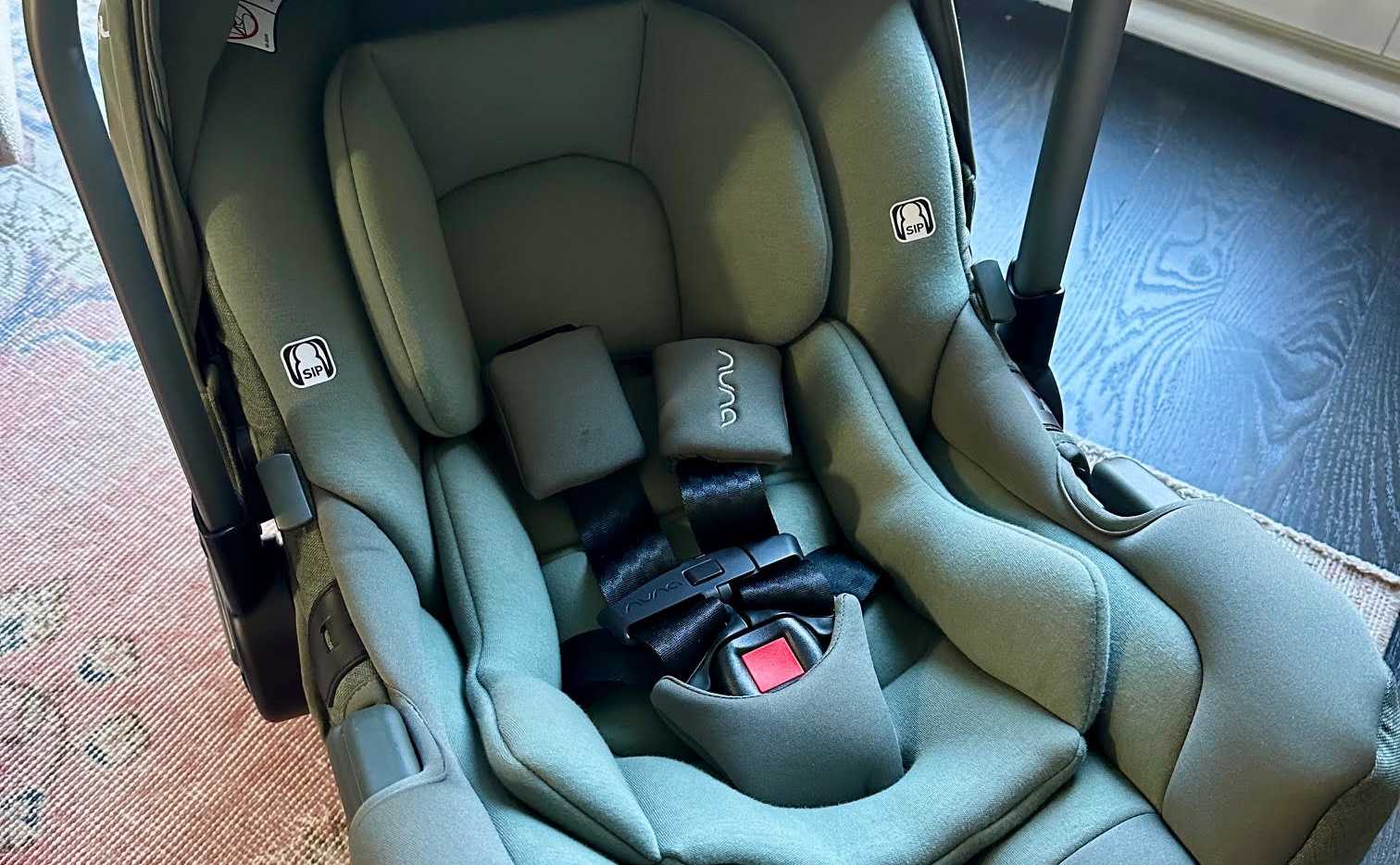
The Nuna Pipa Rx Infant Car Seat in Pine. (Photo: Jen LaBracio, Babylist Senior Gear Editor)
Other Car Seats We Love
If you need an infant car seat to suit a specific need, like an extremely lightweight seat or a seat that works well in a smaller car, these infant car seats earn top spots on our list.
Best Car Seat Stroller Combo
Doona Infant Car Seat & Stroller - Nitro Black
From $650.00Pros
- Infant car seat + stroller all in one
- Convenient for travel and city life
Cons
- Heavy
- Low handlebar can be uncomfortable for taller parents
The Doona was the first of its kind: an infant car seat that instantly transforms into a stroller with the click of a button. It caught on almost immediately and has been a parent favorite for years, consistently called out as a “can’t live without it” item by many Babylist parents in our annual survey.
"The durability and versatility of this one product has made our lives so much easier and efficient!" one parent shared. "It made taking baby out of the house so much easier," said another.
For the right family, the Doona delivers an unbeatable combination of convenience and versatility. It’s ideal for city dwellers who use rideshares frequently or who might have a long walk between their apartment complex and their car, frequent travelers, suburban families who are in and out of the car all day (think parents of multiple kids doing daily preschool dropoff or sports practices for older kids with baby in tow) or for someone who plans to babywear in lieu of using a stroller.
But there are some drawbacks to be aware of. It’s first and foremost a car seat, not a stroller, and like all car seats, it’s not safe for long stretches of sleep. It’s also very heavy, weighing almost 17 pounds—over 10 pounds heavier than some seats on this list. There’s no storage basket. And the handle on the Doona is low, so it can be awkward to push if you’re taller. (I’m 5’10”, and I definitely have to lean over to push it.)
Additional Specs
Child Weight/Height Guidelines: 4-35 lbs, up to 32”
Car Seat Carrier Weight: 17.2 lbs
The Doona quickly and easily transitions from a stroller to a car seat. (Photo: Amanda Michelson, Babylist Senior Manager, Brand Partnerships)
Best Baseless Infant Car Seat
Pros
- Installs quickly and easily without a base
- Perfect for city families who don't own a car
- Most affordable baseless seat on the market
- Lightweight
Cons
- Harness straps must be manually rerouted as baby grows
- Only compatible with Joie strollers
- Baseless is convenient, but you'll need to uninstall and reinstall the seat in your vehicle each time
There are only a few baseless car seats on the market, and the Mint Latch seat from Joie is a personal favorite. While you can install any infant car seat without a base using your vehicle's seat belt, it can be time-consuming, especially as you're learning to get the hang of it. Baseless seats skip the base altogether and instead use rigid LATCH connectors built directly into the seat itself—just click the connectors right into your vehicle and you're good to go. It's a convenient feature for many families, but especially so for urban parents who don’t own a car and rely on rideshares to get around. It's also a good pick for parents who need a seat that switches between cars quickly and easily.
The Mint is the most affordable baseless infant car seat on the market. It weighs about nine pounds, and since no base is needed, it's also fairly compact, especially front-to-back. Just keep in mind that the Mint doesn't feature a no-rethread harness, so you'll need to manually reroute the straps as your baby grows. It's also only compatible with Joie strollers.
Additional Specs
Child Weight/Height Guidelines: 4-30 lbs, up to 30”
Car Seat Carrier Weight: 9.2 lbs
Front view of the Joie Mint Latch Baseless Infant Car Seat. (Photo: Jen LaBracio, Babylist Senior Gear Editor)
Best Lightweight Infant Car Seat
UPPAbaby Aria Lightweight Infant Car Seat - Jake
From $349.99Pros
- Ultra lightweight
- Extra safety features, including anti-rebound bar and stability leg
- GREENGUARD Gold Certified, flame retardant-free
Cons
- Only compatible with UPPAbaby strollers
- Inner seat bottom is narrow, so chunkier babies might feel more cramped
- Often outgrown by height sooner than other infant seats
- Anti-rebound bar and load leg take up more space front-to-back, so will be a tight fit in smaller cars
UPPAbaby’s newest addition to their car seat lineup is our top pick if you’re prioritizing weight when shopping for an infant car seat. At six pounds minus the canopy and inserts, even I was surprised at how light this seat was the first time I picked it up—and I’ve carried a lot of car seats over the years. (The Aria is almost four pounds lighter than UPPA’s other popular infant car seat, the Mesa V2. You can see it in action in our in-depth Aria review.) Safety-wise, there’s an anti-rebound panel and a load leg, and the seat is easy to install thanks to LATCH and visual indicators that turn red if something’s not right.
Additional Specs
Child Weight/Height Guidelines: 4-30 lbs, up to 30”
Car Seat Carrier Weight: 6 lbs (excluding canopy and infant insert)
Our baby model getting ready to ride in the UPPAbaby Aria Lightweight Infant Car Seat. (Photo: Jaclyn Bergmann, Babylist Associate Art Director)
Best Infant Car Seat for Small Cars
Clek Liing Infant Car Seat - Railroad Ziip (Flame Retardant Free)
From $499.99Pros
- Compact & narrow size = good for smaller cars or fitting 3-across
- Fits both smaller and larger infants well
- Packed with safety and comfort features
- Flame retardant-free; some colorways are GREENGUARD Gold Certified
Cons
- Pricey
- Harness straps must be manually rerouted as baby grows
At less than 17 inches across and compact front-to-back, the Clek Liing is ideal if you have a smaller vehicle or if you need to fit multiple car seats across your back seat. And if you’re looking for an infant seat with all of the safety extras, it shines there, too, as a “fan favorite” according to Taylor. It’s also the infant car seat I chose and used for over a year with my second son—exactly because of these safety features.
Like the Nuna Pipa, the Liing uses rigid LATCH, ensuring a tight installation and minimizing the chance your seat will shift during a crash. (There’s also a load leg to reduce crash forces.) Seven different recline positions—15 degrees of total recline—help you achieve the best positioning for your little one, regardless of the angle of your vehicle’s seat. And, unlike many infant seats, you adjust the recline of the base after you install it. "This is a fabulous feature because you don't have to reinstall to change the recline as the baby grows," explains Harrison. "And you don't have to worry about the recline bubble when you are installing." (The Nuna Pipa RX has the same feature, though fewer recline settings than the Liing.)
Additional Specs
Child Weight/Height Guidelines: 4-30 lbs, up to 32”
Car Seat Carrier Weight: 9 lbs
The base of the Clek Liing Infant Car Seat features built-in rigid LATCH connectors. (Photo: Jess MacArthur, Babylist Visual Designer)
What You Need to Know About Infant Car Seats
Most parents choose to register for or buy an infant car seat because it’s designed specifically for younger babies. Other types of car seats include:
Convertible car seats: These grow-with-your-child seats transform from rear-facing car seats for babies and toddlers to forward-facing seats for older children. Some convertible seats can be used from birth, but know that they’re heavy and bulky and aren’t designed to be taken in and out of a vehicle frequently. Many parents choose a convertible car seat as the next step after their child has outgrown their infant car seat. Rotating car seats and all-in-one car seats fall into the convertible car seat category.
Booster seats: A booster seat uses a vehicle’s seat belt as a restraint. Think of a booster as the step between a car seat and a seat belt; it elevates a child in a car’s seat, making adult seat belts fit better on little bodies. You’ll move to a booster once our child maxes out the top limit of their forward-facing convertible car seat.
Infant car seats versus convertible car seats
You'll need a car seat if you plan to take your baby in the car. Whether you choose an infant car seat or a convertible is a matter of personal preference.
Purchasing a convertible car seat means one less piece of baby gear to research and buy. (These are our picks for best convertible car seat, if you decide to switch or start with one.) Convertibles also have a much longer lifespan than infant seats; many will take you from the baby days well into the preschool years, and some even through elementary school. But for most parents, “an infant seat is the right choice for a first car seat,” explains Taylor.
Many convertible car seats don’t fit newborns very well, says Taylor. “There are a few convertible car seats that do, but far and away the newborn fit of an infant seat is more consistent,” she explains. “You also can’t beat the convenience of an infant seat for those quick trips into the store (and seemingly weekly trips to the pediatrician in the beginning). Unless you feel particularly comfortable baby-wearing from birth, for example, it’s difficult to bring a newborn into the grocery store without an infant car seat, as most babies cannot sit up in a shopping cart safely until beyond six months of age.”
Convertible car seats are also heavy and time-consuming to uninstall and reinstall. If your baby will be riding in multiple vehicles, transferring an infant car seat is much easier. (Just be sure to purchase an additional car seat base for your other vehicle.) It’s also easier to transfer a sleeping baby from the car to the stroller (or the other way around) if you’re using an infant car seat that’s compatible with your stroller. This is doable if you purchase a travel system—a car seat and a stroller from the same brand that attach—or create your own set using adapters. (You can check our Car Seat and Stroller Compatibility guide to see which brands work together.)
Why do infant car seats face backward?
“According to the American Academy of Pediatrics and the National Highway Traffic Safety Administration, it's safest for infants and toddlers to ride rear-facing in a car seat for as long as possible,” explains Colella. “This recommendation is based on data showing that rear-facing seats offer better protection in crashes for children from birth through 23 months of age, along with child development and biomechanics considerations.”
How long can babies stay in an infant car seat?
Infant car seats can be used from day one until your baby reaches the seat’s maximum height or weight limit: usually 30-32 inches and 30 pounds.
You'll also need to consider your child's torso height—the length of their upper body. Most rear-facing car seats require an inch of space between the top of a child's head and the top of the car seat. A child with a longer torso may meet the height requirements of a car seat but exceed the one-inch rule, which means it's no longer safe to use that particular seat.
While you can switch as early as you want, according to Taylor, “you must switch if ONE limit of the car seat is met,” she explains. This means that if your child falls within the height limits of your infant car seat but has outgrown the seat’s weight limit (or vice versa), or meets the height and weight limits but whose head is closer than one inch from the top of the seat, it’s time to switch to a convertible car seat. Most babies outgrow their infant seat around one year of age and outgrow a seat by height long before weight, but it can also happen much sooner, depending on your baby’s growth. Let Us Help You Pick Your Next Car Seat is a helpful resource for making the infant-to-convertible switch.
How to Choose a Safe Infant Car Seat
Ask any car seat expert about how to choose the safest car seat and you’ll likely get the same response: all car seats sold in the US must meet the same strict safety regulations and pass all testing and requirements set forth by the National Highway Traffic Safety Administration. (That’s exactly what Joe Colella told us, emphasizing that “a higher price tag does not necessarily equate to more safety.”) But what exactly does that mean, and how does it translate in real life as you shop for an infant car seat and compare features?
According to Colella, the car seat you choose should meet these criteria:
Fits your child. “The right car seat is one designed for your child’s height, weight, age and developmental needs,” he says.
Fits your vehicle. The car seat must be correctly attached to the vehicle to perform its functions. “Following car seat installation instructions and vehicle owner’s manual guidance is crucial.”
Used consistently and correctly. You and anyone else who drives your child need to be familiar with the car seat and its features and should be comfortable using it correctly on every ride.
These three things—how a car seat fits your child, how easy it is to install it in your car and how easy it is to use day in and day out—are inextricably linked to a car seat’s safety. You can buy a seat with all the extra safety features in the world, but if it’s impossible to install or doesn’t fit well in your car, none of the extra bells and whistles matter.
“With hundreds of seats to choose from, rest assured that every single one is a safe choice,” echoes Taylor. “If you’re buying a car seat from a reputable retailer or directly from the manufacturer, it passed rigorous safety testing.” She recommends narrowing down your choices by focusing on four factors: your budget, safety features, unique seat features and compatibility.
Car seat fit
Figuring out if the car seat you like will fit in your car is one of the most common concerns we hear from parents-to-be. And while there’s no substitute for a real-life test, we know how difficult that can be—so here’s what else you can do.
Measure. Measuring isn't foolproof, but it's a good place to start. Before committing to a car seat, look up its dimensions, then break out the measuring tape and spend a few minutes in your car. Don't just focus on hip room measurement (width); make sure to pay attention to features that might impede car seat installation, like high side bolsters or a very tiny middle seat.
Consider car size and driver height. If you drive a compact car, be aware that some larger infant seats likely won't fit as well as more compact models. (This tends to be more of an issue with convertible car seats, which have a much larger footprint than infant seats, but it's still worth noting.) Pay attention to a seat's front-to-back measurement. Also, think about the height of whoever will be riding in front of the infant seat. If they're tall, they'll need more room to push their seat back—which means less room for an infant seat behind it.
Try before you buy. If at all possible, head to a store where you can actually try a seat in your car before registering for it or purchasing it. If that's not possible, consider joining a Facebook group staffed with CPSTs like Car Seats for the Littles where you can get answers on how a particular seat might work in your specific vehicle.
Infant car seat safety features
According to the car seat safety experts we spoke to, these are the safety features to prioritize when shopping for an infant car seat.
Anti-rebound bar: In the event of a crash, a car seat will move toward the point of impact. An anti-rebound bar reduces the movement of a car seat as it moves back into your vehicle’s back seat. It halts the rebound and causes the seat to come to a stop sooner than it would have without the bar.
LATCH: LATCH stands for Lower Anchors and Tethers for CHildren. The LATCH system is an alternate way to secure your car seat that uses built-in anchors and tethers rather than your vehicle’s seat belt. The system consists of two lower anchors found in the seat crack of your car that clip or hook onto two lower attachments on your car seat and a tether anchor behind the back seat that clips onto a tether hook found on the back of your car seat. LATCH is not available in every seating position, so you’ll need to consult your vehicle manual. It's also not always the preferred installation method; every seat usually has one installation method that is recommended by the manufacturer or that will give you better results. Other LATCH facts to note: Both LATCH and seat belt installations are safe, but in most cases are not to be used at the same time, and tere are LATCH weight limits that you need to be aware of before utilizing this system to install your seat.
Side impact protection: “Enhanced side impact protection features can improve child safety in crashes from more directions,” explains Colella. All car seats manufactured after June 30, 2025, will be required to meet side impact performance regulations, but some models already have features built in that have been crash-tested for improved outcomes.
Stability leg/load leg: A load leg is a metal pole that extends from the base of an infant car seat to the floor of a vehicle. Also called stability legs, they reduce the amount of crash energy transferred to a child, according to Colella, specifically to the head and neck. (Not all vehicles allow the use of load legs, however, so always check your owner’s manual.)
You may also want to consider these additional safety features:
Alert systems: These built-in sensor systems are designed to warn a driver if a child is inadvertently left in the car and are something parents should consider when shopping for an infant car seat, according to Colella. Some can also communicate with the driver if the child is not fully buckled in or if other unsafe conditions are occurring.
European belt path vs. American belt path: A belt path is how you’ll install your car seat when you’re not using a base. (Think for travel, rideshares, etc.) Both belt paths start by routing your car’s lap belt over your baby’s lap area. A European belt path wraps the belt around the back of the infant seat for extra protection. Car seat safety experts recommend the European belt path as it allows for a more secure installation and decreases crash forces. The vast majority of seats currently on the market have European belt paths.
No-rethread harness: As your baby grows, you’ll need to adjust your seat’s shoulder straps to accommodate the correct fit. A no-rethread harness means you’ll be able to move the straps up and down without having to manually reroute them through the back of the seat.
Infant car seat convenience features
If you drive often, you’re going to be getting your baby in and out of their car seat quite a bit—so it’s just as important to evaluate ease of use features when you’re researching car seats. “Beyond features directly related to crash performance, parents should consider features that will encourage correct use 100 percent of the time,” explains Colella. These are some to consider.
Canopy: A canopy is an extendable piece of fabric found at the top of a car seat. Canopies extend and retract to provide shade, protection from the elements and privacy for your baby. Note that some infant car seats feature canopies that extend over the entirety of the seat, something to consider if you live in an especially sunny climate or want more privacy for your baby.
Ease of cleaning. “A lesser known fact about car seats is that not all covers are machine washable,” explains Taylor. Babies are messy, and this feature is a must-have for some parents.
Fabric: Besides looking for a style of fabric that matches your taste, consider its durability and how easy it’ll be to wash when messes happen. You may also want to consider an infant car seat with GREENGUARD Gold Certification, which means both the item and its manufacturing process were tested and reviewed for over 10,000 chemical and VOC emissions, or a flame retardant-free seat.
Fit: Car seats range in size and shape. The way a car seat fits in your specific vehicle is both a convenience feature (especially if you’re on the taller side or prefer to recline your seat) and a safety feature (a safe car seat is one that fits properly in your car’s back seat and can be secured correctly).
Peekaboo window: A peekaboo window is a small opening found in the fabric of a car seat canopy. It’s often made of mesh or another type of sheer fabric and lets you get a quick peek at what your little one is up to without having to retract the canopy or sneak around the side of the seat. It also provides added air flow.
Stroller compatibility: You can snap infant car seats into many strollers or stroller frames. You can buy a prearranged set, like a travel system, or mix and match brands as long as they are compatible via car seat adapters.
Weight: A lightweight seat isn’t a necessity, but it makes carrying around your baby easier on your arms and back.
Infant Car Seat Frequently Asked Questions
Where is the best place to put an infant car seat?
The center of your vehicle’s back seat is statistically the safest place to install your child’s car seat. That’s because many crashes involve a side impact, so a middle position will help to avoid direct impact. However, not all vehicles allow for a car seat in every spot that has a seat belt. If you can’t install your car seat in the center, choose the position where you can install it tightly using either LATCH or your vehicle’s seat belt, according to the AAP’s car seat safety information guidelines. And always check your specific vehicle’s owner’s manual before installation. The Safe Kids’ Ultimate Car Seat Guide Installation Tips is a great resource for car seat installation.
Can my baby sleep in their infant car seat?
Yes, babies can fall asleep in an infant car seat, but it’s important to then transfer them to a safe sleep space like a crib or a bassinet, as the AAP recommends against the use of car seats for sleep outside of a car. The AAP also advises that babies have a break from the car seat every 90 minutes.
Can I buy a used infant car seat?
Car seat safety experts always recommend purchasing any car seat new, as a used seat may be damaged or may not meet current safety regulations. If you do end up selecting a used infant car seat, get it from someone you trust. Be sure the seat has never been in a crash, look up the seat’s expiration date and check for any recalls through NHTSA. If the seat is dirty, follow the manufacturer’s strict rules around how to clean the car seat; each seat has a specific set of cleaning instructions to maintain the seat’s safety and integrity.


